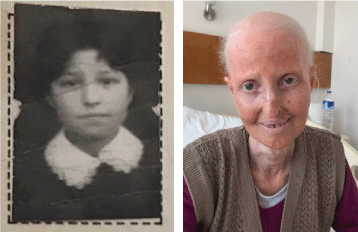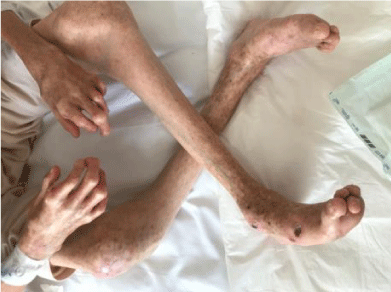A Rare Disease with Premature Aging, Case Report
Milan Jokanović1*, Zoran Šegrt2, Miloš P Stojiljković3, Dragana Ristić2 and Bojan Kovač2
1Experta Consulting, Belgrade, Serbia
2Military Medical Academy, Belgrade, Serbia
3Faculty of Medicine, University of Banja Luka, Banja Luka, Republic of Srpska, Bosnia and Herzegovina
*Address for Correspondence: Cansu Erel, Department of Internal Medicine, Istanbul Faculty Of Medicine, Istanbul University, Istanbul, Turkey, Tel: +90-212- 414-2000/ 32134; Fax: + 90-212-414-2028; ORCID ID: https://orcid.org/0000-0002-6427-9886; E-mail: [email protected]
Submitted: 03 November 2019; Approved: 07 November 2019; Published: 08 November 2019
Citation this article: Erel C, Tascioglu C. A Rare Disease with Premature Aging, Case Report. American J Rare Dis Diagn Ther. 2019;2(1): 012-014.
Copyright: © 2019 Erel C, et al. This is an open access article distributed under the Creative Commons Attribution License, which permits unrestricted use, distribution, and reproduction in any medium, provided the original work is properly cited
Keywords: Werner’s syndrome; Progeria; Premature aging; Rare diseases
Download Fulltext PDF
Background: Werner’s syndrome, known as adult progeria, is a rare progressive disorder characterized by accelerated aging and cancer predisposition. The frequency of the syndrome is estimated 1 case in 1,000,000.
Case Presentation: In this paper, we would like to contribute medical literature by reporting an interesting case of 45-year-old-women, following up for 22 years with Werner’s syndrome manifesting all typical features of the disease.
Conclusions: Werner’s syndrome is a rare disease with unique features. However, it is difficult to recognize because of slow manifestation of typical signs and symptoms. There is no cure option at the moment, early diagnosis and following up these patients are essential because of rehabilitation needs, multiple comorbidities and cancer predisposition.
Background
Werner’s syndrome, known as “adult progeria” is a rare progressive disorder characterized by accelerated aging and cancer predisposition. The disorder was originally described in the medical literature in 1904 by German scientist Otto Werner. The frequency of the syndrome is estimated 1 case in 1,000,000 individuals as well as occurs more often in Japan and Sardinia, affecting 1 in 20,000. It is inherited in an autosomal recessive pattern causing mutations of Werner’s syndrome [WRN] gene on 8p12 chromosome. The Werner’s syndrome [WRN] gene provides producing Werner protein which is related DNA repair, DNA replication and cell division. The features of the syndrome are scleroderma-like skin changes especially in the extremities, cataract, premature arteriosclerosis, diabetes mellitus and a wizened prematurely aged facies. Although the disorder is typically recognized by the third or fourth decades of life, characteristic findings are found during adolescence and early adulthood [1-3].
Case Presentation
M A, a 45-year-old-woman was admitted to the hospital complaining of purulent discharge from both elbows and hips. About 2 years prior to admission the patient had noted similar complaints which were diagnosed and treated as osteomyelitis.
She stated to be healthy until 23 years old when she had a surgery for bilateral cataracts. She was not diabetic then and doctors said “cataract is arising from her body” in the words of patient. Following the operation her complaints started with often falls, weight loss and muscle weakness. The symptoms had been thought as drug adverse effects while her hair became feathery and sparse together with deformation of legs’ shape causing progressive difficulty in her walking. She has not walked for 10 years which explicit deterioration has occurred. Stiffness, muscle contractures on joints and paresthesia especially on hands has caused decreasing her self-care ability which she couldn’t eat or take a shower by her own since 2016. Painful recurrent sores which were diagnosed and treated as osteomyelitis developed recently on defined joints.
The periods had started at the age of 14. She had married at 20 and got pregnant once at 23 ended up stillbirth with an unfound cause after 9 months gestation. She had hysterectomy operation because of uterine residual tissue. She divorced from her husband after delivery.
The parents of the patient weren’t relatives yet they were from the same village. The patient had 3 siblings who all had cataract history despite of absent diabetes mellitus. Otherwise there was no relatives suffered from Werner’s syndrome. A sister had asthma and goiter while a brother had cerebral hemorrhage which the etiology was unclear. Other brother was healthy.
The patient weighed 23 kg with cachexia appearance. She was on average intelligence and looked cheerfully. As hallmark of Werner’s syndrome she looked like extremely older than she was because of disproportion between patient’s real age and appearance. Strikingly characteristic scleroderma-like appearance of Werner›s syndrome was seen on the patient’s face which were atrophic and tight skin, prominent eyes, beaked nose and constriction of the mouth. She had diffuse alopecia and few feathery white hair as well as sparse eyebrows and eyelashes (Figure 1,2).
She complained about difficulty on seeing near. Oropharynx was clear except oral hygiene was not well and she lost a number of her teeth. The voice was weak and high- pitched confirmed by the patient’s statement. Patient also expressed hoarseness since 2016 which was thought to be related cervical bronchogenic cyst on neck.
Precuts excavate was noted on respiratory system examination. Respiratory and cardiac auscultation revealed normal sounds. There was loose skin on abdomen and slight tenderness on umbilical area but no palpable masses, defines or rebound.
She had spindly arms and legs with marked atrophy of musculature. Besides severe wasting (Atrophy) of extremity muscles, deficiency of adipose tissue was noted. Moreover, distinct contractures caused flexion’s and limited movements of joints for both extremities. She couldn’t walk or stand because of rocker bottom feet formation. There were multiple small necrotic ulcerations noted on fingertips (Figure 3).
Conclusions
Werner’s syndrome is a rare disease with unique features. However, it is difficult to recognize because of slow manifestation of typical signs and symptoms. There is no cure option at the moment, early diagnosis and following up these patients are essential because of rehabilitation needs, multiple comorbidities and cancer predisposition.
Author’s Contributions
CE did manuscript writing/ editing. CT was involved manuscript editing. Both authors read and approved the final manuscript.
Consent for Publication
Written informed consent was obtained from the patient for publication of this case report and any accompanying images. A copy of written consent is available for review by the Editor-in-Chief of this journal.
- Rare disease database. 2018. https://bit.ly/2JXSpjm
- Werner Syndrome: WRN. 2018. https://bit.ly/2NPQqyx
- Junko Oshima, George M Martin, Fuki M Hisama. Werner syndrome. GeneReviews. 2016. https://bit.ly/2Nr6LLl



Sign up for Article Alerts